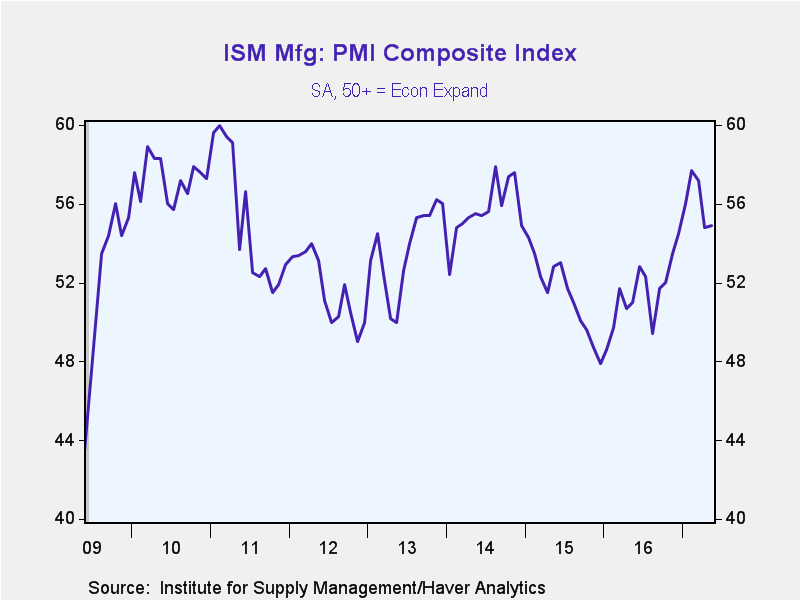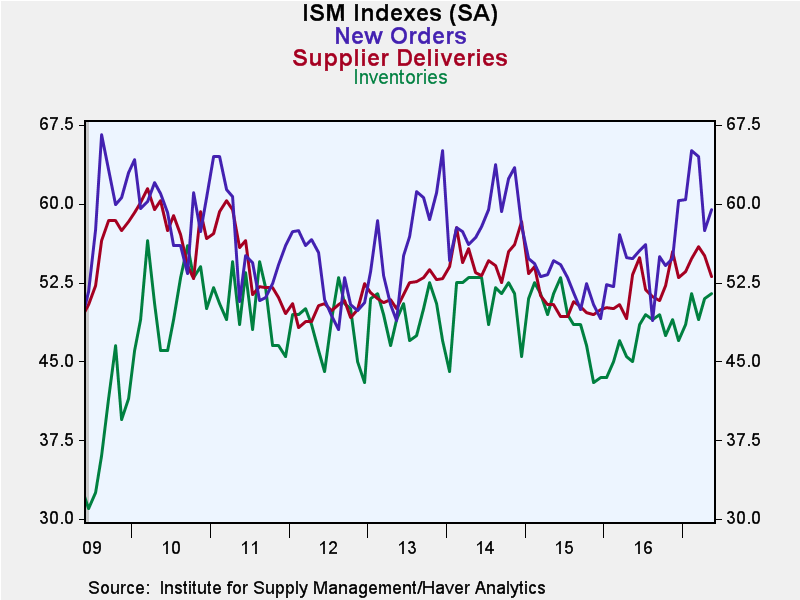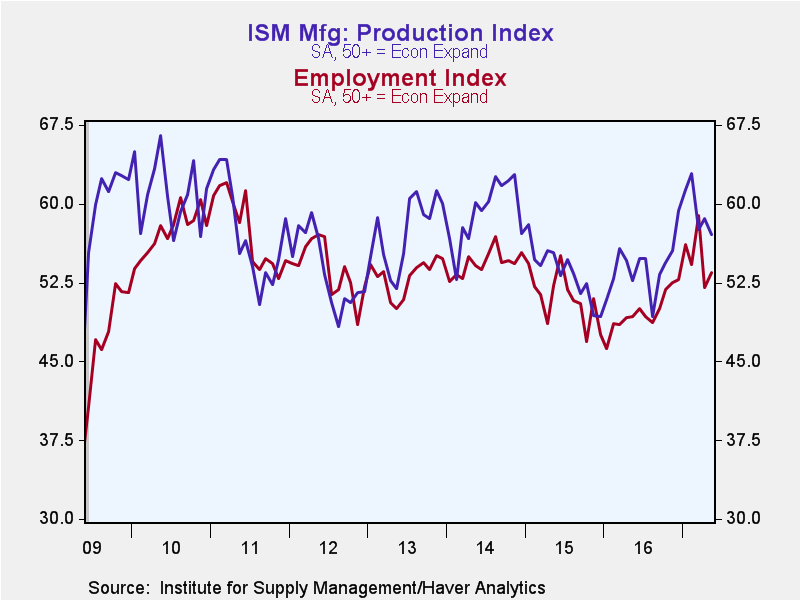 Global| Jun 01 2017
Global| Jun 01 2017ISM Factory Sector Index Remains Steady
by:Tom Moeller
|in:Economy in Brief
Summary
The ISM factory sector composite index, at 54.9, was little changed last month from April's reading of 54.8. The figure has been trending higher since Q4'15. A level of 54.8 had been expected in the Action Economics Forecast Survey. A [...]
The ISM factory sector composite index, at 54.9, was little changed last month from April's reading of 54.8. The figure has been trending higher since Q4'15. A level of 54.8 had been expected in the Action Economics Forecast Survey.
A rise in the new orders reading to 59.5 from 57.5 led the overall index higher. The figure remained down versus 65.1 three months ago. The inventories index also improved slightly to 51.5, showing the strongest rate of accumulation in nearly two years. Other component series weakened. The production index fell to 57.1, the lowest level in six months. The supplier delivery series declined to 53.1, indicating the quickest product delivery speeds since December.
The employment index increased to 53.5 from 52.0. The figure remained, nevertheless, close to the lowest since December. The index has reflected a rising level of jobs for eight straight months. During the last ten years, there has been an 85% correlation between the index level and the m/m change in factory sector payrolls. Twenty-three percent of respondents indicated rising payrolls while 12 percent reported a decline.
The prices paid reading declined to 60.5, but remained stronger versus the low of 33.5 in January 2016. Thirty percent (NSA) of respondents reported paying higher prices while nine percent paid less.
Amongst other detailed readings, the export order index fell to 57.5, but remained up from the 2015 low of 46.5. The order backlog reading of 55.0 was reduced moderately from its highs earlier this year, but remained up sharply from 2015 and 2016. The imports index also fell moderately.
The ISM figures are diffusion indexes where a reading above 50 indicates increase. The figures from the Institute for Supply Management can be found in Haver's USECON database. The expectations number can be found in Haver's AS1REPNA database.
| ISM Mfg (SA) | May | Apr | Mar | May'16 | 2016 | 2015 | 2014 |
|---|---|---|---|---|---|---|---|
| Composite Index | 54.9 | 54.8 | 57.2 | 51.0 | 51.5 | 51.4 | 55.6 |
| New Orders | 59.5 | 57.5 | 64.5 | 54.9 | 54.7 | 52.6 | 58.9 |
| Production | 57.1 | 58.6 | 57.6 | 52.7 | 54.0 | 53.5 | 59.2 |
| Employment | 53.5 | 52.0 | 58.9 | 49.3 | 49.7 | 51.0 | 54.4 |
| Supplier Deliveries | 53.1 | 55.1 | 55.9 | 53.3 | 51.9 | 50.7 | 55.0 |
| Inventories | 51.5 | 51.0 | 49.0 | 45.0 | 47.2 | 49.0 | 50.8 |
| Prices Paid Index (NSA) | 60.5 | 68.5 | 70.5 | 63.5 | 53.5 | 39.8 | 55.6 |
Tom Moeller
AuthorMore in Author Profile »Prior to joining Haver Analytics in 2000, Mr. Moeller worked as the Economist at Chancellor Capital Management from 1985 to 1999. There, he developed comprehensive economic forecasts and interpreted economic data for equity and fixed income portfolio managers. Also at Chancellor, Mr. Moeller worked as an equity analyst and was responsible for researching and rating companies in the economically sensitive automobile and housing industries for investment in Chancellor’s equity portfolio. Prior to joining Chancellor, Mr. Moeller was an Economist at Citibank from 1979 to 1984. He also analyzed pricing behavior in the metals industry for the Council on Wage and Price Stability in Washington, D.C. In 1999, Mr. Moeller received the award for most accurate forecast from the Forecasters' Club of New York. From 1990 to 1992 he was President of the New York Association for Business Economists. Mr. Moeller earned an M.B.A. in Finance from Fordham University, where he graduated in 1987. He holds a Bachelor of Arts in Economics from George Washington University.










